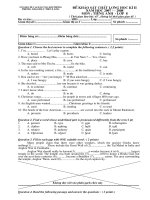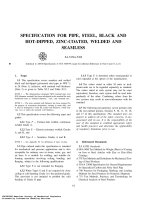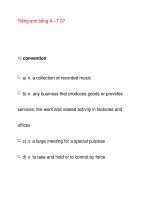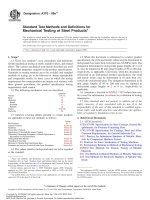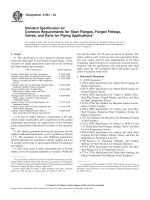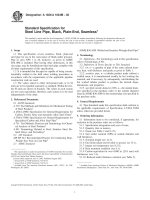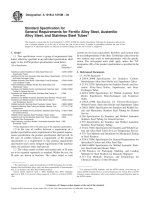Astm a 604 a 604m 07 (2017)
Bạn đang xem bản rút gọn của tài liệu. Xem và tải ngay bản đầy đủ của tài liệu tại đây (1.02 MB, 14 trang )
This international standard was developed in accordance with internationally recognized principles on standardization established in the Decision on Principles for the
Development of International Standards, Guides and Recommendations issued by the World Trade Organization Technical Barriers to Trade (TBT) Committee.
Designation: A604/A604M − 07 (Reapproved 2017)
Standard Practice for
Macroetch Testing of Consumable Electrode Remelted Steel
Bars and Billets1
This standard is issued under the fixed designation A604/A604M; the number immediately following the designation indicates the year
of original adoption or, in the case of revision, the year of last revision. A number in parentheses indicates the year of last reapproval.
A superscript epsilon (´) indicates an editorial change since the last revision or reapproval.
This standard has been approved for use by agencies of the U.S. Department of Defense.
1. Scope
2. Referenced Documents
2.1 ASTM Standard:4
E381 Method of Macroetch Testing Steel Bars, Billets,
Blooms, and Forgings
2.2 ASTM Adjunct:3
Adjunct to A604/A604M Practice for Macroetch Testing of
Consumable Electrode Remelted Steel Bars and Billets
1.1 This practice2 covers testing and inspection and is
applicable to bars, billets, and blooms of carbon, alloy, and
stainless steel which have been consumable electrode remelted.
1.2 For the purpose of this practice, the consumable electrode remelting process is defined as a steel refining method
wherein single or multiple electrodes are remelted into a
crucible producing an ingot which is superior to the original
electrode by virtue of improved cleanliness or lower gas
content or reduced chemical or nonmetallic segregation. See
Appendix X1 and Appendix X2 for descriptions of applicable
remelting processes.
3. Description of Macroetch Testing
3.1 This practice employs the action of an acid or other
corrosive agent to develop the characteristics of a suitably
prepared specimen. After etching, the sections are compared
visually, or at a very low magnification, if necessary for
clarification of conditions, to standard plates describing the
various conditions which may be found. Materials react differently to etching reagents because of variations in chemical
composition, method of manufacture, heat treatment, and many
other variables.
1.3 This practice and the accompanying comparison macrographs3 are generally applicable to steel bar and billet sizes
up to 225 in.2 [1450 cm2] in transverse cross section.
1.4 The values stated in either SI units or inch-pound units
are to be regarded separately as standard. The values stated in
each system may not be exact equivalents; therefore, each
system shall be used independently of the other. Combining
values from the two systems may result in non-conformance
with the standard.
4. Significance and Use
4.1 Macroetch testing, as described herein, is a method for
examining and rating transverse sections of bars and billets to
describe certain conditions of macro segregation which are
often characteristic of consumable electrode remelted materials.
1.5 This standard does not purport to address all of the
safety concerns, if any, associated with its use. It is the
responsibility of the user of this standard to establish appropriate safety and health practices and determine the applicability of regulatory limitations prior to use.
4.2 This practice is not intended to define major defects
such as those described by Method E381.
5. Application
5.1 When material is furnished subject to macroetch testing
and inspection under this practice, the manufacturer and
purchaser should be in agreement concerning the following:
5.1.1 The stage of manufacture at which the test shall be
conducted,
5.1.2 The number and location of the sections to be tested,
1
This practice is under the jurisdiction of ASTM Committee A01 on Steel,
Stainless Steel and Related Alloys and is the direct responsibility of Subcommittee
A01.06 on Steel Forgings and Billets.
Current edition approved March 15, 2017. Published March 2017. Originally
approved in 1970. Last previous edition approved in 2012 as A604/
A604M – 07(2012). DOI: 10.1520/A0604_A0604M-07R17.
2
ASTM Committee A01 gratefully acknowledges the help of the AISI Committee on General Metallurgy in preparing the appendix, assembling the macroetch
photographs, and assisting with the text of this practice.
3
A complete set of the 20 macrographs on glossy paper available from ASTM
International Headquarters. Order Adjunct No. ADJA0604. Original adjunct produced in 1985.
4
For referenced ASTM standards, visit the ASTM website, www.astm.org, or
contact ASTM Customer Service at For Annual Book of ASTM
Standards volume information, refer to the standard’s Document Summary page on
the ASTM website.
Copyright © ASTM International, 100 Barr Harbor Drive, PO Box C700, West Conshohocken, PA 19428-2959. United States
1
A604/A604M − 07 (2017)
5.1.3 The condition and preparation of the surface to be
macroetched,
5.1.4 The etching reagent, temperature and time of etching,
or degree of etching including any special techniques which
must be used, and
5.1.5 The type and degree of conditions or combinations
thereof that shall be considered acceptable or subject to
metallurgical review.
NOTE 1—The reagents in 7.2.1, 7.2.2, and 7.2.3 should be used under
ventilating hoods or with some provision to remove the corrosive fumes.
7.2.4 Nitric Acid—This etchant consists of 5 % HNO3
solution in alcohol or water, and is generally used at room
temperature. When this reagent is used, the etch disk must have
a smooth surface.
8. Etching Containers
8.1 Macroetching must be done in containers that are
resistant to attack from the etching reagents. Caution must be
exerted to prevent the occurrence of electrolytic couples which
can cause uneven attacks and misleading results.
6. Sample Preparation
6.1 Unless otherwise specified, the test shall be performed
on specimens, usually 1⁄4 to 1 in. [6 to 25 mm] thick, cut to
reveal a transverse surface.
9. Preparation of Etched Surface and Examination
6.2 Disks for macroetch inspection may be removed from
billets by a variety of methods including torch cutting, sawing,
machining, or high-speed abrasive wheels. Adequate preparation of the surface for macroetching must completely remove
the effects of torch cutting or high-speed abrasive wheels.
9.1 Upon completion of etching, surfaces of disks should be
cleaned by either chemical or mechanical methods that do not
affect the macroetch quality. Care should be taken to prevent
rusting of the etched surface.
6.3 Due to the nature of the conditions to be detected,
further surface preparation is usually required.
10. Interpretation of Conditions Found by Macroetching
10.1 Four distinct classes of conditions are defined and
described under this practice:
10.1.1 Class 1: Freckles—Circular or near-circular dark
etching areas generally enriched with carbides and carbideforming elements.
10.1.2 Class 2: White Spots—Light etching areas, having no
definitive configuration or orientation which are generally
reduced in carbide or carbide-forming elements.
10.1.3 Class 3: Radial Segregation—Radially or spirally
oriented dark etching elongated areas occurring most frequently at mid-radius which are generally carbide enriched.
This condition may be easily confused with freckles in some
materials.
10.1.4 Class 4: Ring Pattern—One or more concentric rings
evidenced by a differential in etch texture associated with
minor composition gradients and ingot solidification.
6.4 When such further preparation is performed, grinding,
machining, or sanding should be carried out in such a manner
as not to mask the structure.
6.5 The surface of the disk to be etched must be free of dirt,
grease, or other foreign material which might impair the result
of the test.
7. Etching Reagents
7.1 The etching response and appearance is dependent upon
the type and temperature of the etching reagent and the time of
immersion. These details must be established by agreement
between manufacturer and purchaser.
7.2 For illustrative purposes some of the commonly used
etching reagents are as follows:
7.2.1 Hydrochloric Acid—A solution of 1 part commercial
concentrated hydrochloric acid (HCl, sp gr 1.19) and 1 part
water is more generally used than any other macroetching
reagent. This solution may be heated without significant
change in concentration, and may be reused if it has not
become excessively contaminated or weakened. Etching is
generally done with the solution at a temperature of approximately 160 °F [70 °C].
7.2.2 Hydrochloric Acid-Sulfuric Acid Mixture—A mixture
containing 50 % water, 38 % commercial concentrated HCl,
and 12 % commercial concentrated sulfuric acid (H2SO4, sp gr
1.84) is sometimes used in place of the previously mentioned
50 % HCl solution. The statements in the previous paragraph
regarding reuse and temperature of etchant are applicable to
this reagent.
7.2.3 Aqua Regia—A solution consisting of 1 part concentrated nitric acid (HNO3, sp gr 1.42) and 2 parts concentrated
HCl is used on corrosion and heat-resistant materials of the
18 % chromium, 8 % nickel type and higher alloy types. This
reagent is used at room temperature.
10.2 Macroetch photographs show examples of each of the
conditions revealed by macroetch testing, with five degrees of
severity, identified as A, B, C, D, and E for each condition.
Degree A exhibits the minimum occurrence of each condition
detectable by visual examination of the etched surface, while
degrees B, C, D, and E represent increasing severity of
occurrence.
10.3 For each condition, or combination of conditions,
ratings shall be obtained by comparing each macroetched
section with the standard photographs. Bar or billet sections to
225 in.2 [1450 cm2] cross-sectional area may be rated against
these standards. Larger sizes may be rated by agreement
between manufacturer and purchaser, but caution must be
exercised in interpretation of such results. Figs. 1-20 have been
reduced 44 % in area from the standard photographs.
10.4 If the appearance of a given condition does not exactly
match one of the five standard photographs, it shall be assigned
the rating of the standard that it most nearly matches.
2
A604/A604M − 07 (2017)
FIG. 1 Class 1—Freckles—Severity A
FIG. 2 Class 1—Freckles—Severity B
10.5 No standards for acceptance are stated or implied in
these illustrations. The extent to which each condition may be
permissible varies with the intended application, and such
standards should be stated in the applicable product
specification, or may be the subject of negotiation between
manufacturer and purchaser.
11. Keywords
11.1 consumable electrode remelting; electroslag remelting;
freckles; macro etching; radial segregation; ring pattern; segregation; vacuum arc remelting; white spots
3
A604/A604M − 07 (2017)
FIG. 3 Class 1—Freckles—Severity C
FIG. 4 Class 1—Freckles—Severity D
4
A604/A604M − 07 (2017)
FIG. 5 Class 1—Freckles—Severity E
FIG. 6 Class 2—White Spots—Severity A
5
A604/A604M − 07 (2017)
FIG. 7 Class 2—White Spots—Severity B
FIG. 8 Class 2—White Spots—Severity C
6
A604/A604M − 07 (2017)
FIG. 9 Class 2—White Spots—Severity D
FIG. 10 Class 2—White Spots—Severity E
7
A604/A604M − 07 (2017)
FIG. 11 Class 3—Radial Segregation—Severity A
FIG. 12 Class 3—Radial Segregation—Severity B
8
A604/A604M − 07 (2017)
FIG. 13 Class 3—Radial Segregation—Severity C
FIG. 14 Class 3—Radial Segregation—Severity D
9
A604/A604M − 07 (2017)
FIG. 15 Class 3—Radial Segregation—Severity E
FIG. 16 Class 4—Ring Pattern—Severity A
10
A604/A604M − 07 (2017)
FIG. 17 Class 4—Ring Pattern—Severity B
FIG. 18 Class 4—Ring Pattern—Severity C
11
A604/A604M − 07 (2017)
FIG. 19 Class 4—Ring Pattern—Severity D
FIG. 20 Class 4—Ring Pattern—Severity E
12
A604/A604M − 07 (2017)
APPENDIXES
(Nonmandatory Information)
X1. CONSUMABLE ELECTRODE VACUUM MELTING
crucible, only a portion of the ingot is molten at a time and
solidification proceeds in a continuously progressive manner.
X1.1 Process Description
X1.1.1 Consumable electrode vacuum melting (CEVM) of
steel has grown from a laboratory process to a major production operation capable of producing ingots in certain grades up
to 60 in. [1500 mm] in diameter, weighing 50 tons [45 t]. The
available ingot sizes and weights vary from grade to grade,
depending upon their complexity and alloy content. Currently,
a significant proportion of the ultra-high-strength steels for
aircraft and missiles, bearing steels for aircraft engines, and
other speciality alloys are being consumable electrode vacuum
melted.
X1.2 Product Characteristics
X1.2.1 Essentially, the CEVM operation changes the properties of steel in three ways:
X1.2.1.1 By reducing gas content.
X1.2.1.2 By improving microcleanliness. The nonmetallic
inclusion content is rated in a manner similar to that used for
air melt except that the level is generally lower and a different
chart is used.
X1.2.1.3 By changing the mode of solidification from that
of the traditional static-cast ingot to a progressive solidification
process, involving high heat input from an arc and rapid heat
extraction by the water-cooled copper crucible.
X1.1.2 The consumable electrode vacuum melting process
is diagramed in Fig. X1.1. To start the melting operation, an
electrode produced from conventional air-melted or vacuumprocessed steel is suspended in the consumable electrode
vacuum melting furnace. The system is evacuated and an arc is
struck to a bottom starting pad. Molten metal is transferred
across the arc from the electrode to the solidifying ingot
contained within the water-cooled copper crucible. As melting
proceeds and the ingot solidifies progressively upward, the
electrode is fed downward to maintain the proper arc length. As
the metal droplets pass through the arc, they are exposed to this
vacuum at extremely high arc temperatures, producing extensive degassification, as well as some breakdown and dispersion
of inclusions. Due to the rapid cooling provided by the copper
X1.2.2 Depending upon the grade of steel and the application under consideration, consumable electrode vacuum melting is reported to significantly improve one or more of the
following properties: transverse ductility in aircraft forging
billets, fatigue strength or endurance limit, notched tensile
strength or fracture toughness, Charpy V-notch impact
strength, stress rupture, and creep strength. Furthermore, hot
workability and yield of some grades are significantly improved. The CEVM process has also made possible the
development of new alloys for extremely high-strength or
FIG. X1.1 Consumable Electrode Vacuum Melting Furnace
13
A604/A604M − 07 (2017)
high-temperature applications that did not exhibit satisfactory
properties when melted by other methods.
X1.3 Macrotech Characteristics
X1.3.1 Consumable electrode vacuum-melted steels and
alloys may contain discontinuities peculiar to this process
which are disclosed upon macroetch examination.
X2. ELECTROSLAG REMELTING
X2.1 Process Description
X2.1.1 Electroslag remelting (ESR) was first introduced in
an American patent by Hopkins, but most of the published
work has been done by Russian engineers. The process has
been shown to reduce inclusions, similar to vacuum-arc
remelting, with the additional benefit of reducing sulfur content
in critical alloys for aerospace and nuclear applications. Many
variations of processing parameters, equipment design, ingot
sizes and shapes are used.
X2.1.2 The ESR process consists of remelting a consumable
electrode through a bath of molten slag using the electrical
resistance of the slag to provide the required heat input. The
slag composition will vary with the type of alloy and the
processor’s objectives. Single or three-phase ac or dc current
may be applied. Water-cooled ingot molds may be square,
round, or designed to produce rough tube rounds. Stationary
molds or molds that can be raised as the ingot solidifies are
used. Starting the process may be done with cold slag and
starter chips or molten slag prepared in a small arc furnace. A
diagram of this process is shown in Fig. X2.1.
X2.2 Product Characteristics
X2.2.1 The ingot surface is protected by a film of slag that
solidifies on the ingot as it cools, providing an improved
surface.
X2.2.2 Sulfur content may be reduced substantially to
improve workability.
FIG. X2.1 Schematic of ESR Melting Process
X2.2.3 A significant drop in oxide inclusions may be
obtained.
X2.3 Macrotech Characteristics
X2.2.4 Improved uniformity occurs due to the solidification
process.
X2.3.1 ESR steels and alloys may contain discontinuities
peculiar to this process which are disclosed upon macroetch
.
examination
X2.2.5 Little, if any, loss in alloying elements occurs with
appropriate processing parameters.
ASTM International takes no position respecting the validity of any patent rights asserted in connection with any item mentioned
in this standard. Users of this standard are expressly advised that determination of the validity of any such patent rights, and the risk
of infringement of such rights, are entirely their own responsibility.
This standard is subject to revision at any time by the responsible technical committee and must be reviewed every five years and
if not revised, either reapproved or withdrawn. Your comments are invited either for revision of this standard or for additional standards
and should be addressed to ASTM International Headquarters. Your comments will receive careful consideration at a meeting of the
responsible technical committee, which you may attend. If you feel that your comments have not received a fair hearing you should
make your views known to the ASTM Committee on Standards, at the address shown below.
This standard is copyrighted by ASTM International, 100 Barr Harbor Drive, PO Box C700, West Conshohocken, PA 19428-2959,
United States. Individual reprints (single or multiple copies) of this standard may be obtained by contacting ASTM at the above
address or at 610-832-9585 (phone), 610-832-9555 (fax), or (e-mail); or through the ASTM website
(www.astm.org). Permission rights to photocopy the standard may also be secured from the Copyright Clearance Center, 222
Rosewood Drive, Danvers, MA 01923, Tel: (978) 646-2600; />
14
